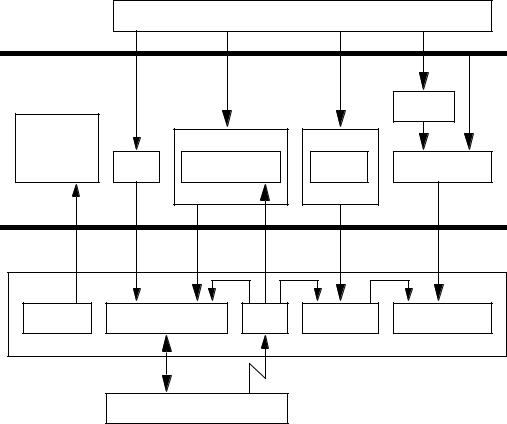
Добавил:
Andrey
Опубликованный материал нарушает ваши авторские права? Сообщите нам.
Вуз:
Предмет:
Файл:Sauermann J.Realtime operating systems.Concepts and implementation of microkernels for embedded systems.1997.pdf
X
- •List of Figures
- •List of Tables
- •Preface
- •1 Requirements
- •1.1 General Requirements
- •1.2 Memory Requirements
- •1.3 Performance
- •1.4 Portability
- •2 Concepts
- •2.1.1 Compiling and Linking
- •2.2 Loading and Execution of Programs
- •2.3 Preemptive Multitasking
- •2.3.1 Duplication of Hardware
- •2.3.2 Task Switch
- •2.3.3 Task Control Blocks
- •2.3.4 De-Scheduling
- •2.4 Semaphores
- •2.5 Queues
- •2.5.1 Ring Buffers
- •2.5.2 Ring Buffer with Get Semaphore
- •2.5.3 Ring Buffer with Put Semaphore
- •2.5.4 Ring Buffer with Get and Put Semaphores
- •3 Kernel Implementation
- •3.1 Kernel Architecture
- •3.2 Hardware Model
- •3.2.1 Processor
- •3.2.2 Memory Map
- •3.2.3 Peripherals
- •3.2.4 Interrupt Assignment
- •3.2.5 Data Bus Usage
- •3.3 Task Switching
- •3.4 Semaphores
- •3.4.1 Semaphore Constructors
- •3.4.2 Semaphore Destructor
- •3.4.3 Semaphore P()
- •3.4.4 Semaphore Poll()
- •3.4.5 Semaphore V()
- •3.5 Queues
- •3.5.1 Ring Buffer Constructor and Destructor
- •3.5.2 RingBuffer Member Functions
- •3.5.3 Queue Put and Get Functions
- •3.5.4 Queue Put and Get Without Disabling Interrupts
- •3.6 Interprocess Communication
- •3.7 Serial Input and Output
- •3.7.1 Channel Numbers
- •3.7.2 SerialIn and SerialOut Classes and Constructors/Destructors
- •3.7.3 Public SerialOut Member Functions
- •3.7.4 Public SerialIn Member Functions
- •3.8 Interrupt Processing
- •3.8.1 Hardware Initialization
- •3.8.2 Interrupt Service Routine
- •3.9 Memory Management
- •3.10 Miscellaneous Functions
- •4 Bootstrap
- •4.1 Introduction
- •4.3.1 Task Parameters
- •4.3.2 Task Creation
- •4.3.3 Task Activation
- •4.3.4 Task Deletion
- •5 An Application
- •5.1 Introduction
- •5.2 Using the Monitor
- •5.3 A Monitor Session
- •5.4 Monitor Implementation
- •6 Development Environment
- •6.1 General
- •6.2 Terminology
- •6.3 Prerequisites
- •6.3.1 Scenario 1: UNIX or Linux Host
- •6.3.2 Scenario 2: DOS Host
- •6.3.3 Scenario 3: Other Host or Scenarios 1 and 2 Failed
- •6.4 Building the Cross-Environment
- •6.4.1 Building the GNU cross-binutils package
- •6.4.2 Building the GNU cross-gcc package
- •6.4.3 The libgcc.a library
- •6.5 The Target Environment
- •6.5.2 The skip_aout Utility
- •7 Miscellaneous
- •7.1 General
- •7.2 Porting to different Processors
- •7.2.1 Porting to MC68000 or MC68008 Processors
- •7.2.2 Porting to Other Processor families
- •7.3 Saving Registers in Interrupt Service Routines
- •A Appendices
- •A.1 Startup Code (crt0.S)
- •A.3 Task.cc
- •A.6 Semaphore.hh
- •A.7 Queue.hh
- •A.8 Queue.cc
- •A.9 Message.hh
- •A.10 Channels.hh
- •A.11 SerialOut.hh
- •A.12 SerialOut.cc
- •A.13 SerialIn.hh
- •A.14 SerialIn.cc
- •A.15 TaskId.hh
- •A.18 ApplicationStart.cc
- •A.19 Monitor.hh
- •A.20 Monitor.cc
- •A.22 SRcat.cc
- •Index

3. Kernel Implementation |
33 |
|
|
3 Kernel Implementation
3.1Kernel Architecture
Figure 3.1 shows the overall architecture of the kernel implementation.
|
|
|
Application |
|
|
Application |
|
|
|
|
|
Kernel |
|
|
|
|
|
|
|
|
|
|
Queue |
Application |
|
Serial I/O |
Task |
|
|
Startup |
os |
Queue |
|
Queue |
Semaphore |
|
|
||||
User Mode |
|
|
|
|
|
Supervisor |
|
|
|
|
|
Mode |
|
|
|
|
|
Startup |
Hardware Access |
ISR |
Scheduler |
P(), V(), Poll() |
|
crt0.S |
|
|
|
|
|
Hardware (DUART)
FIGURE 3.1 Kernel Architecture
The bottom part of Figure 3.1 shows the part of the kernel that is (along with the functions called from there) executed in supervisor mode. All code that is
Соседние файлы в предмете Электротехника
